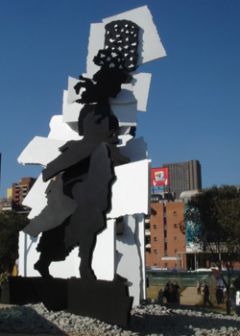The Art of Public Space: Curating and Re-imagining the Ephemeral City

The Art of Public Space grew out of a research project of the African Centre for Cities at the University of Cape Town. The book combines urban studies with cultural studies to examine how a different South African city, Johannesburg, is being used as a canvas for artistic practices in public. These pieces grapple with the legacies of apartheid and stratified space in Johannesburg’s inner city.
For instance, in the controversial Chandelier, the gay, Jewish, white performance artist Steven Cohen dressed up as a human chandelier. He attached wrought iron to his otherwise bare body and walked through the settlement of Newtown while “Red Ants”, a notorious security firm, were forcibly evicting residents. The piece was a commentary on urban precariousness and violence.
A less temporary artwork is Fire Walker, a public sculpture that was erected in 2010. From a certain angle, its multiple components join to depict a woman carrying a brazier on her head – a nod to informal roadside traders. The sculpture is positioned in such a manner that it is best viewed by pedestrians. Therefore it can be interpreted as questioning the priority given to motorized transport in Johannesburg’s planning.
The examples in The Art of Public Space extend to audio pieces, digital games, flash mobs, films, poster art, participatory plays, guided walks, and other forms. Kim Gurney does not make artistic judgements about the individual works. Rather, she is interested in what they say about how performers and residents engage with Johannesburg as a vehicle for artistic expression. Thus the book contains theoretical discussions of the implications of public art and urban space, alongside descriptions of the many individual art projects that make Johannesburg a rich site of analysis.
There is an institutional framework for this flowering of creative expression. “The City of Johannesburg’s public art policy includes a provision whereby new development projects invest up to 1 per cent of their capital budget on public art. This has encouraged a spate of public art investments in the city and related precinct upgrades” (8).
Of course, the privileged position of many South African artists and the abstract value of art in general raise questions about the utility of government-funded public art in such an unequal city. The examples given in The Art of Public Space suggest that some people are using public art as a means of exercising urban citizenship, dissent, and place-making. Inevitably, the specific forms this takes will not be to everyone’s taste. Gurney’s thesis is that these re-imaginings of the city are essential to the debate on how urban processes are playing out, and should not be treated merely as a tool of economic regeneration.
Further reading:
Beall, Jo, Owen Crankshaw and Susan Parnell (2000), “Local government, poverty reduction and inequality in Johannesburg”, Environment and Urbanization Vol 12, No 1, pages 107–122, available at http://eau.sagepub.com/content/12/1/107.abstract.
Malone, Karen (2002), “Street life: youth, culture and competing uses of public space”, Environment and Urbanization Vol 14, No 2, pages 157–168, available at http://eau.sagepub.com/content/14/2/157.abstract.
Pieterse, Edgar (2009), “Post-Apartheid Geographies In South Africa: Why Are Urban Divides So Persistent?”, Interdisciplinary Debates on Development and Cultures: Cities in Development—Spaces, Conflicts and Agency, Leuven University, 15 December, available at http://www.africancentreforcities.net/wp-content/uploads/2013/10/post-apartheid_geographies_pieterse_15dec09.pdf.
Image used with permission from the City of Johannesburg website (http://www.joburg.org.za/index.php?option=com_content&view=article&id=5604:basa-nominations-for-jda&catid=88&Itemid=340)
Book note prepared by Christine Ro
Search the Book notes database
Our Book notes database contains details and summaries of all the publications included in Book notes since 1993 - with details on how to obtain/download.
Use the search form above, or visit the Book notes landing page for more options and latest content.
For a searchable database for papers in Environment and Urbanization, go to http://eau.sagepub.com/

